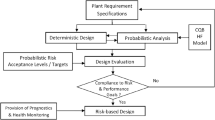Abstract
In nuclear power plants (NPPs), safety is the major concern. Probabilistic safety assessment (PSA) has become a key tool as on today to identify and understand NPP vulnerabilities. PSA models have been successfully employed during design evaluation to assess weak links and carry out design modifications to improve system reliability and safety. As a result of the availability of these PSA studies, one can make use of them to enhance plant safety and to operate the plants in the most efficient manner. This necessitates development of software tools like living PSA, risk monitor etc. Risk monitor is a PC based tool, which computes the real time safety level based on the actual status of systems and components and assists plant personnel and regulatory authorities to manage day-to-day activities and can provide solutions to various regulatory decision making issues. This paper discusses various modules and data flow diagrams of risk monitor and also discusses how common cause failures are treated in risk monitor. In risk monitor, risk is subjected to the change in the state of the system, which in turn depends on the state of the components and these are explained with a case study.






Similar content being viewed by others
References
Regulatory Guide-1.174 (2008) An Approach for using probabilistic risk assessment in risk-informed decisions on plant-specific changes to the licensing basis. USNRC, Washington, DC
EPRI NP-5613 (1988) Procedures for treating common cause failures in safety and reliability studies, Vol. 1, NUREG/CR-4780
Hari Prasad M, Vinod Gopika, Saraf RK, Ghosh AK (2005) Application of PSA in risk informed decision making. Paper presented at the international conference on reliability, safety and hazards, Mumbai, 1–3 December 2005
Hari Prasad M, Gopika V, Saraf RK, Ghosh AK (2006) Risk monitor a tool for operational safety assessment, Report BARC/2006/E/016, July 2006
IAEA-TECDOC-1106 (1999) Living probabilistic safety assessment (LPSA). IAEA, Vienna
IAEA-TECDOC-737 (1994) Advances in reliability analysis and probabilistic safety assessment for nuclear power reactors. IAEA, Vienna
Nakai R, Kani Y (1991) A Living PSA system LIPSAS for an LMFBR. Paper presented at the international symposium on the use of PSA for operational safety, PSA’91, Vienna, 3–7 June 1991
RG1.177 (2002) An approach for plant-specific, risk-informed decision making : technical specifications. US Nuclear Regulatory Commission, Washington, DC
Saraf RK, Hari Prasad M, Ghosh AK (2005) Treatment of common cause failures in risk monitor”. Paper presented in the international conference on reliability and safety engineering, Bhubaneswar, 21–23 December 2005
Smith Curtis L (1998) Calculating conditional core damage probabilities for nuclear power plant operations. Reliab Eng Syst Saf 59:299–307
Author information
Authors and Affiliations
Corresponding author
Rights and permissions
About this article
Cite this article
Hari Prasad, M., Vinod, G. & Sanyasi Rao, V.V.S. Risk management of NPPs using risk monitors. Int J Syst Assur Eng Manag 6, 191–197 (2015). https://doi.org/10.1007/s13198-014-0295-5
Received:
Revised:
Published:
Issue Date:
DOI: https://doi.org/10.1007/s13198-014-0295-5




